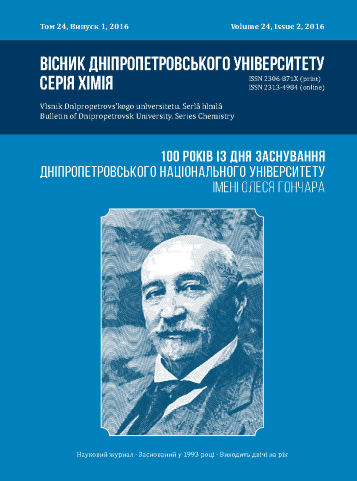Styromal based polymer films modified with copper microparticles
DOI:
https://doi.org/10.15421/081612Keywords:
polymeric composite material, polymeric matrix, styromal, oligodiol, static exchange capacity, sorption of Cu2 -ions, copper microparticles, electroplatingAbstract
A method for the synthesis of polymeric film based on a copolymer of styrene and maleic anhydride (stiromal) and oligodiol was suggested. Block copolymer of ethylene glycol and propylene glycol was used as oligodiol. It was shown that synthesized materials have moderate water swelling capacity in and ion-exchange properties. Static exchange capacity in 0.1 mol/L NaOH aqueous solution is within the interval of 1.44–1.76 mmol/g. At air-dry state films have a tensile strength of 4–6.6 MPa and an elongation at break tensile 38–61 %. The effect of stiromal molecular weight and oligodiol type, and conditions of film formation on ion-exchange and physical-mechanical properties of the films was studied. The synthesized material appeared to be able to sorb Cu2+-ions from neutral and acidic solutions. The distribution coefficient in case of sorption from slightly acidic solution with Cu2+ concentration of 50 mg/L was 48–50. Composite material with a metal submicroparticles uniformly distributed in the polymeric matrix was obtained by chemical reduction of copper ions sorbed. It was found that the film acquires electric conductivity, as a result of filling of metal particles, which allows copper electrodeposition on the film surface.References
Mamunia, Ye. P., Yurzhenko, M. V., Lebediev, Ye. V. Levchenko, V.V., Chervakov, O.V., Matkovska, O.K. & Sverdlikovska O.S. (2013). [Electroactive polymer materials]. Kyiv, Ukraine: Alfa Reklama (in Russian).
Pomohailo, A. D. (2000). Hybrid polymer-inorganic nanocomposites. Russ. Chem. Rev., 69 (1), 53–80. doi:10.1070/rc2000v069n01abeh000506 CrossRef
Mamunia, Ye. P., Vasylenko, S. L., Parashchen¬ko, I. M., Lebediev, Ye. V. & Shut M. I. (2003). [Structure and electrical properties of conductive polymer composites]. Kompozytsiini polimerni materialy – Composite polymeric materials, 25(1), 36–42.
Kozarenko, O. A. (2011). [Spectral and electrochemical properties of electro-leading polymers and their nanocomposites with vanadium oxide obtained by mechano-chemical way] (Unpublished doctoral dissertation). Kyiv, Ukraine (in Ukrainian).
Pomohailo, A. D. (2002). [Metal-polymer nanocomposites with controlled molecular architecture]. Zhurn. Ros. Khim. Obshchestva Im. D. I. Mendeleeeva – Journal of Russian Chemical Society named after D. I. Mendeleev, XLVI(5), 64–73.
Jurkov, G. Ju. (2009). [The scientific basis of obtaining new functional composite materials based on d-metal nanoparticles and polymeric matrixes (polyethylene and polytetrafluoroethylene), and study of their physical and chemical properties] (Unpublished doctoral dissertation). Saratov, Russian Federation (in Russian).
Zaitseva, V. V., Tiuryna, T. H., & Zaitsev S. Yu. (2009). [Copolymerization of styrene with acrylonitrile and maleic anhydride]. Vysokomol. soedineniia. Ser. B – Macromolecular compounds. Series B, 51(2), 298–306.
Tiuryna, T. H., Zaitseva, V. V., Bulavyn, A. V., & Hainulyna, M. R. (2008). [Synthesis and esterification of styrene and maleic anhydride copolymers]. Voprosy Khimii i Khimicheskoi Tekhnologii – Issues of Chemistry and Chemical technology, (2), 78–81.
Volynskyi, A. L., Nykonorova, V. A., Volkov A. V., Moskvina, M. A., Tunian, A. A., Iaryshev, N. G., Arzhakova, O. V., Dolgova, A. A., Rukhlia, E. G., Trofimchuk, E. S., Abramchuk, S. S., Iarysheva, L. M. & Bakeev, N. F. (2010). [The method of obtaining nanocomposites noble metal-polymer matrix].
Nikonorova, N. I., Trofimchuk, E. S., Semenova, E. V. Volynskii A. L. & Bakeev N. F. (2000) [Thermo¬chemical reduction of Copper in porous polyethylene matrix]. Vysokomolekuliarnye soedineniia Seriia A. – Macromolecular Compounds. Series A, 42(8), 1298–1306.
Volynskij, A. L., Jarysheva, L. M., Lukovkin, G. M., & Bakeev, N. F. (1992). [Electrochemical method of preparation of metal-polymer systems]. Vysokomolekuliarnye soedineniia Seriia A. – Macromolecular compounds. Series A, 34(6), 24–27.
Khutsishvili, S. S., Vakulskaya, T. I., Kuznetso¬va, N. P., Ermakova, T. G., Pozdnyakov, A. S. & Prozorova, G. F. (2014). Formation of stable paramagnetic nanocomposites containing zero-valence silver and copper in a polymeric matrix. J. Phys. Chem. C, 118(33), 19338–19344. doi:10.1021/jp5045207 CrossRef
Kotik, F. I. (1948). [Speed control of electrolyte solutions and melts. The directory]. Moscow, USSR: Mashinostroenie (in Russian).
Downloads
Published
Issue
Section
License
Copyright (c) 2016 Oles Honchar Dnipropetrovsk National University

This work is licensed under a Creative Commons Attribution 4.0 International License.
- Authors reserve the right of attribution for the submitted manuscript, while transferring to the Journal the right to publish the article under the Creative Commons Attribution License. This license allows free distribution of the published work under the condition of proper attribution of the original authors and the initial publication source (i.e. the Journal)
- Authors have the right to enter into separate agreements for additional non-exclusive distribution of the work in the form it was published in the Journal (such as publishing the article on the institutional website or as a part of a monograph), provided the original publication in this Journal is properly referenced
- The Journal allows and encourages online publication of the manuscripts (such as on personal web pages), even when such a manuscript is still under editorial consideration, since it allows for a productive scientific discussion and better citation dynamics (see The Effect of Open Access).


